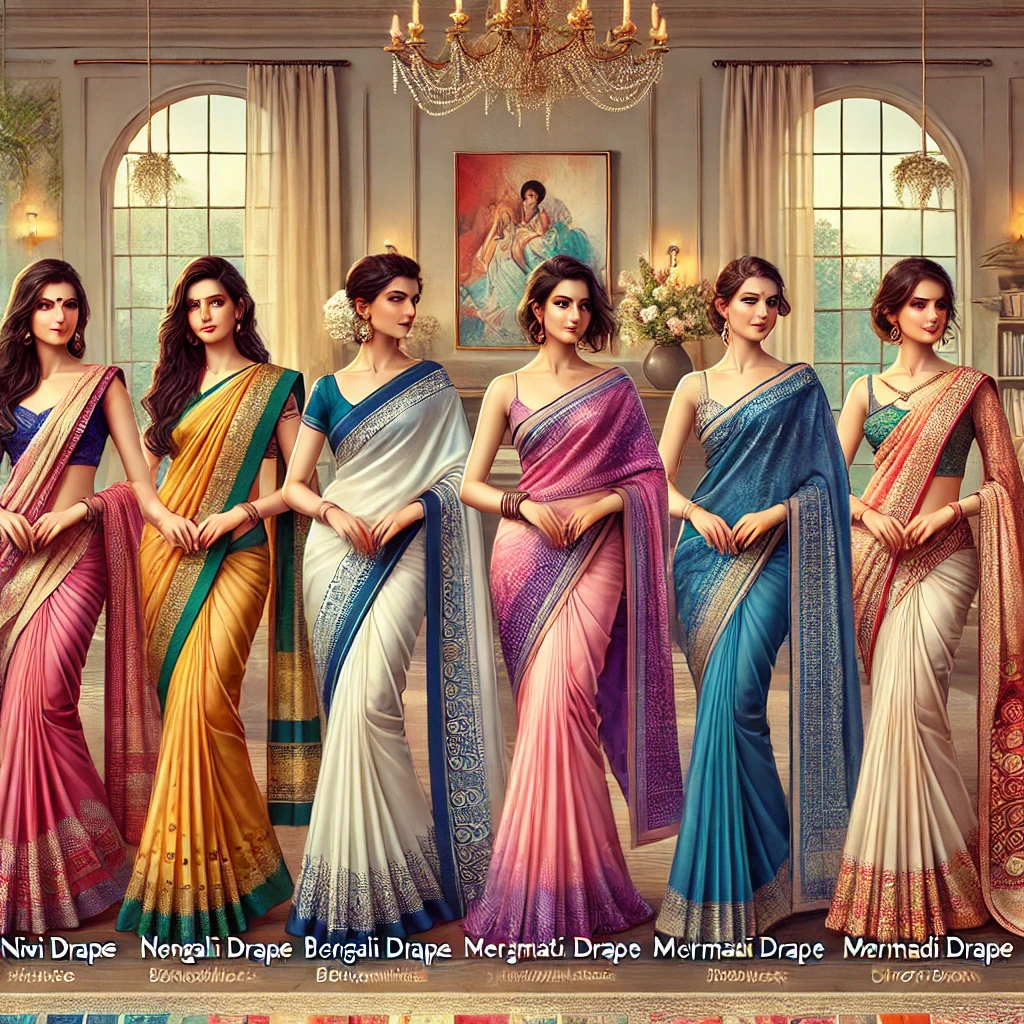What is Saree?
A saree is a beautiful and timeless piece of traditional wear for women, especially popular in India and other South Asian countries. A saree is a long, elegant fabric, typically 5 to 9 yards, beautifully draped around the body, showcasing timeless grace and cultural heritage in its every fold.
The saree, paired with a blouse (choli) and an underskirt (petticoat), offers endless versatility in draping styles, influenced by region, culture, or personal taste. The most popular style is the Nivi drape, where pleats are tucked gracefully at the waist, and the pallu flows elegantly over the shoulder. As a timeless outfit, the saree is perfect for weddings, festivals, and any special occasion, combining tradition with beauty effortlessly
Sarees come in a wide range of fabrics like cotton, silk, chiffon, and georgette, and they can feature intricate embroidery, vibrant prints, or handwoven designs. Each region of India has its own unique saree styles, such as Kanjeevaram silk from Tamil Nadu, Banarasi silk from Varanasi, or Bandhani from Rajasthan.
As a piece of traditional wear, the saree is more than just clothing—it represents the rich cultural heritage and elegance of Indian fashion. It’s worn during festivals, weddings, and celebrations, but it’s also loved for its versatility in everyday life.

Types of Saree:
Saree on the basis of Geography
Banarasi Saree: Originating from Varanasi, these sarees are famous for their luxurious silk and intricate gold or silver brocade work. They are often adorned with floral motifs and are a popular choice for weddings.
Kanjeevaram Saree: Hailing from Tamil Nadu, these sarees are renowned for their vibrant colors and durable silk fabric. They feature intricate patterns inspired by temples, nature, and traditional art.
Bandhani Saree: A specialty of Rajasthan and Gujarat, Bandhani sarees are created using the tie-dye technique. Their vibrant colors and dotted patterns symbolize festivity and are perfect for joyous occasions.
Chanderi Saree: Originating from Madhya Pradesh, Chanderi sarees are known for their lightweight fabric and delicate handwoven motifs, often depicting peacocks, florals, or traditional geometric designs.
Patola Saree: From Gujarat, these double-ikat silk sarees are prized for their vibrant, symmetrical patterns, and detailed craftsmanship, reflecting an heirloom-quality appeal.
Tant Saree: A traditional cotton saree from West Bengal, Tant sarees are ideal for daily wear due to their light and airy texture, often featuring floral and geometric designs.
Saree on the basis of Fabric
- Silk: Rich and luxurious fabric, perfect for weddings and special events.
- Cotton: Light and breathable, great for daily wear and comfort.
- Chiffon: Soft and flowing material, ideal for elegant and modern looks.
- Georgette: Lightweight with a slightly textured feel, easy to drape beautifully.
- Linen: Cool and airy fabric, perfect for summer and casual occasions.
- Velvet: Soft and royal-looking, often chosen for festive or bridal sarees.
- Organza: Transparent and crisp fabric, giving a delicate and stylish finish.
- Crepe: Smooth and light, suitable for chic and contemporary styles.
- Tussar Silk: Textured and earthy silk, great for a traditional appearance.
- Net: Sheer and trendy, often decorated with embroidery for party wear.

5 Stunning Saree Draping Styles You Must Try
1.Nivi Drape
The most popular and timeless style, the Nivi drape involves pleating the saree at the waist and elegantly draping the pallu over the shoulder. Perfect for weddings, festivals, or formal events, this classic look is both graceful and easy to carry.
2. Bengali Drape
Known for its charm, the Bengali drape leaves the pallu loose and flows beautifully across the shoulder. Often accessorized with traditional jewelry, this style is ideal for festive occasions and cultural celebrations.
3. Gujarati Drape
In this style, the pallu is brought to the front over the right shoulder, showcasing intricate designs or embroidery. It’s a favorite for weddings and special ceremonies, offering a regal and elegant appearance.
4. Mermaid Drape
For a modern and fitted look, the mermaid drape hugs the body’s curves and gives a saree a gown-like appearance. This chic style is perfect for parties or receptions, exuding sophistication and glamour.
5. Dhoti Drape
A contemporary twist on saree draping, the dhoti drape is trendy and experimental. Tied like a dhoti, it allows freedom of movement while adding a bold and stylish vibe to your outfit—perfect for fashion-forward events.
Benefits of Saree:
- Versatility: Suitable for weddings, festivals, or everyday wear, with endless draping styles.
- Elegance: Enhances beauty with a timeless and graceful appeal.
- Comfort: Offers breathability and ease, especially in lightweight fabrics like cotton or chiffon.
- Cultural Connection: Reflects heritage and regional traditions in its design and craftsmanship.
- Flattering Fit: Adapts to all body types, making every woman look stunning.
- Durability: High-quality sarees, like silk or Banarasi, last for years, often passed down generations.
- Eco-Friendly: Many sarees are made from sustainable, natural fabrics like cotton or silk.